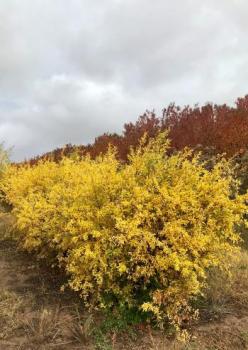November 17, 2018

Question:
Why are some cottonwood trees turning brown rather than yellow this fall? Sometimes a portion of the tree (often the lower portion) turns brown while the crown does turn yellow. I think I have seen this in other years, but this fall it seems more pronounced. Is it weather related? Moisture?
- Wes B., Albuquerque, NM
Answer:
Explanations for why leaves change color the way they do can be related to the species or cultivar, temperature fluctuations, seasonal day length changes, and potentially the soil moisture levels too. A general rule is that while temperature tends to affect the intensity of leaf color, it's the shorter days and longer nights that trigger overall color change.
Chlorophyll is the green pigment that starts the process of photosynthesis by helping convert sunlight, carbon dioxide, and water into sugars that travel through the plant to other branches or roots where the plant uses them as food. Normally, chlorophyll breaks down and is remade continually throughout the season, but in the fall when the days get shorter, veins that carry water and nutrients to the leaves start to close off, so less chlorophyll is made and more and more chlorophyll breaks down. As the green color fades, other pigments that were there all along, like yellow and sometimes orange, can be seen.
When a cold snap comes and chlorophyll in still-green leaves doesn’t have time to slowly break down, the leaves can change straight to brown, skipping the golden stage altogether. Microclimates within individual tree canopies can create temperature differences that might cause the outer canopy to turn bright yellow while the inner canopy stays green until a brisk night when the leaves turn brown in a flash.
Red and brown colors are normal in different oaks, depending largely on the species. Pecans can turn a beautiful bronze. Aspens and cottonwoods are known for their potential to display yellows and golds. Pomegranates can also be an unbelievable bright yellow.
Here’s a fun color activity you can do at home. Find a green leaf and some rubbing alcohol. Tear a paper towel or coffee filter into strips. Rip up the leaf and then mash it in a little rubbing alcohol using a blender, mortar and pestle, or the blunt end of a wooden spoon to rupture the leaf cells and let the chlorophyll (and other pigments!) run out, turning the alcohol bright green. Pour the green alcohol into a cup and dip one edge of the paper towel or coffee filter in the liquid. If your paper strip is long enough—or the cup is short enough—you can drape the paper over the edge and let it sit. The pigments are made up of different molecules that run through the paper at different rates, so you’ll likely see the yellow color separate from the green and you might see some oranges, depending on the species. If you can’t find green leaves outside in your area right now, that’s OK because you can do this project using any old plant leaf, including spinach, parsley, or a leaf from a houseplant.

Red pigments are a little different. In many species, they are thought to form in the fall when veins close and sugars get trapped in leaves where they react with other chemicals to form red pigments. This is where temperature makes the process even more beautiful. When days are bright and nights are cold, more sugars are trapped and the red colors can intensify.
The red and green pigments, anthocyanins and chlorophylls, are the same as those found in red and green chiles.
Other folks have also asked about color anomalies this season. Connie C. remarked that the pecans near Doña Ana seem noticeably prettier this year. The peach trees in Los Lunas were spectacular last year and this year too. At the NMSU Agricultural Science Center at Los Lunas, where I am based, we have 23 cultivars of peach trees that were planted in 2007 in rows with four trees for each cultivar. From afar, you could distinguish between cultivars just based on foliage color.
Dave T. sent in a related question from Las Cruces: "We planted a pistache in our front garden for the interesting fall and spring colors. The pistache trees around Las Cruces are turning gorgeous shades of red and orange, while ours is as green as the middle of summer. What are we doing wrong?"
Because fall color is controlled by cultivar, day length, and temperature, there may not be much you can do to ramp up your Chinese pistache color performance next season. Water might have an effect, but restricting water and possibly stressing your tree to see if you can get more wow factor seems like a drastic approach. I predict that there will come a time when other pistache owners are scratching their heads because their colors aren't up to par and you'll be the ones basking in the glow that year. Maybe 2019 will be stellar. Time will tell.
Marisa Y. Thompson, PhD, is the Extension Horticulture Specialist, in the Department of Extension Plant Sciences at the New Mexico State University Los Lunas Agricultural Science Center, email: desertblooms@nmsu.edu, office: 505-865-7340, ext. 113.
Links:
For more gardening information, visit the NMSU Extension Horticulture page at Desert Blooms and the NMSU Horticulture Publications page.
Send gardening questions to Southwest Yard and Garden - Attn: Dr. Marisa Thompson at desertblooms@nmsu.edu, or at the Desert Blooms Facebook page.
Please copy your County Extension Agent and indicate your county of residence when you submit your question!